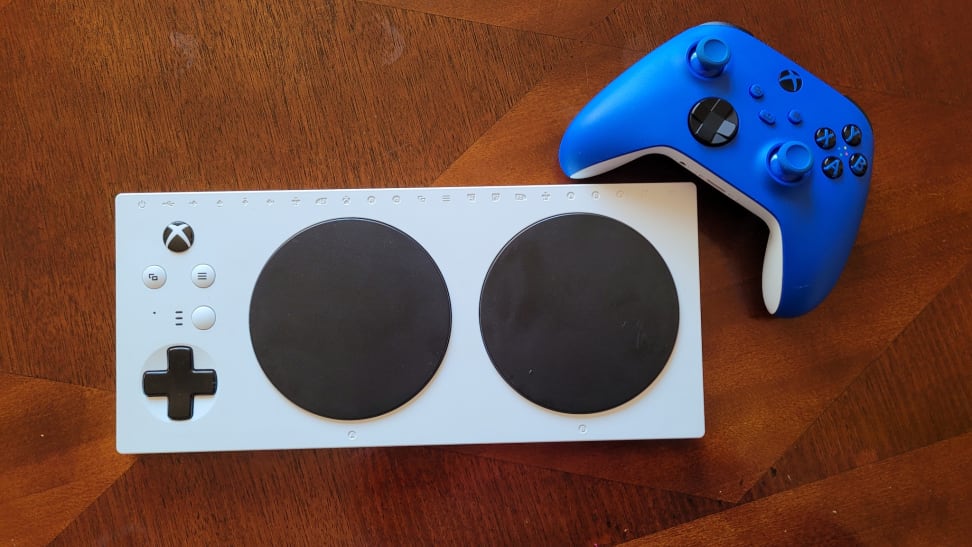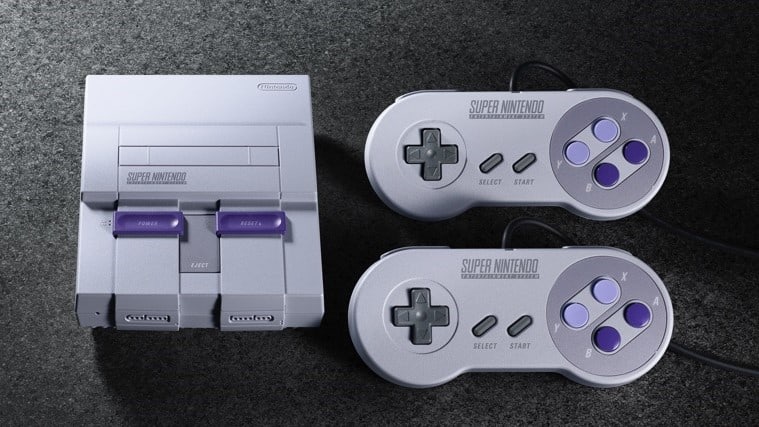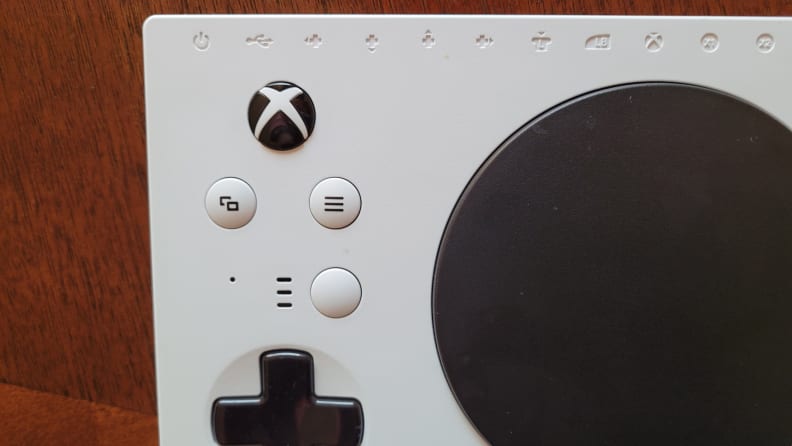Microsoft's Adaptive Controller makes the Xbox accessible to all
Many video games have a barrier to entry. Microsoft aims to change that.
 Credit:
Reviewed / Sarah Kovac
Credit:
Reviewed / Sarah Kovac
Products are chosen independently by our editors. Purchases made through our links may earn us a commission.
I still remember the pure ecstasy I felt that Christmas my parents got me a Super Nintendo. I’d played video games at friends’ houses, so I knew I’d be able to use the controller without a problem, even though I’d be using my feet due to a disability in my arms and hands. Many hours were consumed with Donkey Kong, Super Mario World, and even the incredibly frustrating Paperboy.
I could keep up with my friends until one of them got a Sega. As much as I loved playing Sonic the Hedgehog, I found the controller’s shape and button layout difficult to navigate. That was the beginning of the end of gaming for me, as over the years controllers grew buttons all over—way more than I could manage with two big toes.

For you younger folks, this is a Super Nintendo and controllers from ye olden tymes.
It’s a bummer that people like me have been excluded from the gaming community because gaming itself is largely inaccessible to those with disabilities. It’s been about 30 years since the Sega started pushing me out of video gaming, and with the hype surrounding the new Xbox Series X, that loss has become more pronounced. But in 2018 Microsoft decided to bring folks with dexterity challenges back into the fold by creating the Adaptive Controller. This year, I decided to give it a try.
What does the Adaptive Controller do?
The Adaptive Controller works with Xbox consoles and Windows PCs. Using just the Adaptive Controller without any external controls or switches, you’ll be quite restricted in the number and types of games you can play, as it's limited to a direction pad and A/B buttons. You won't find the joysticks, bumpers, or triggers that are standard on regular Xbox controllers. This is largely because the Adaptive Controller is designed to be used with accessories.
You can assign any of the Adaptive Controller’s buttons to act as a Shift on a keyboard, activating assignable alternate functions for the rest of the buttons. (For example, you could assign the B button as Shift.) When holding down Shift, your d-pad (up/down, left/right) can become the A, B, X, and Y buttons.
So, taking the Shift function into account, the Adaptive Controller by itself can replicate up to 11 button functions of a standard Xbox controller. That is something, but it isn’t enough to explore all the actions in a game like Madden. You’ll also be limited as to which buttons you can push at the same time.

The blank button scrolls through presets 1-3. You can tell which preset you're on by the indicator lights next to it.
Custom presets are helpful here, allowing gamers to have four different sets of functions that can be quickly accessed with a button press. Scrolling through some menus in Madden '20 on my Xbox One X, I needed the right and left bumper buttons, but I had not assigned those buttons to any on the Adaptive Controller, opting instead for the oft-used right and left triggers. With one button press, I can switch to a different profile that has RB and LB assigned to the right and left buttons on the d-pad.
Though I didn't try this myself, another way to use the Adaptive Controller is with the Copilot setting on Xbox One. This allows two controllers (standard or adaptive) to work in tandem for one player. So, if I wanted to play Madden to its fullest potential, I could ask a friend to take a second controller and push the buttons I can’t reach as I play with the Adaptive Controller.
What are the available accessories?
To take gameplay up a notch, or several, you can attach any of a multitude of adaptive switches, joysticks, or foot controls. I use several of these as I create media content without the use of my hands, so I was excited to see whether I could add enough peripheral controls to really play a more complicated game. As I love my Chiefs, I opted for Madden '20.

Each controller function has its own port, where you can plug in adaptive devices.
I went through the game training to try to decipher which buttons were most important so that I could program the controller accordingly and connect any necessary external switches. This sounds simple, but as I’d never played this game before, it took me hours of fiddling to find a configuration I felt I could live with. The total cost of the controller and peripherals I ended up using? $218.98. Ouch. And there are plenty of highly specialized switches that cost more than the ones I used. Here are a few examples:
- Adaptive Controller: $99.99
- 3D Rudder: $99
- One-handed joystick: $19.99
I found that I could play well enough with just the Adaptive Controller and 3D Rudder, but having no right joystick meant I missed out on some fun moves, and even this simple setup is pretty pricey. Luckily, a charity called Able Gamers—which was actually involved with the Adaptive Controller's design—helps gamers with disabilities not only find the best adaptive gaming equipment, but also helps them afford it. It might be worth a look if you're turned off by the price tag.
Is the Adaptive Controller worth the money?
The hardest part of making all this work wasn’t the physical aspect. It was trying to remember which buttons I’m supposed to push in the game, translating those into the array of gadgets in my lap and at my feet, and pulling the correct lever in time. I started to feel like a one-woman band after a while. I’m positive that with lots of practice, this could become natural. But, I mean, lots.
I don’t know that there’s a way around the very steep learning curve that comes with using this adaptive tech with a modern game, but for those who have lost motor function and want to play the games they used to, this setup might be the best solution.
For people like me who haven’t been able to really play video games since Sonic was born, however, setting up and acclimating to this way of playing is a big ask. I’m not sure if I’ll continue to work on my Xbox skills, but I do know that if there’s any demographic with the resilience and determination to make something like this work, it’s people with disabilities.


